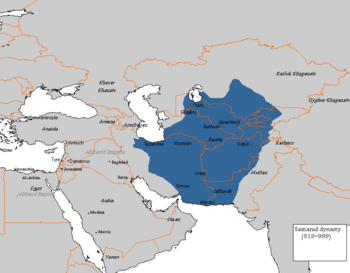Samanid Empire facts for kids
Quick facts for kids
Samanid Empire
سامانیان
|
|||||||||||||||||||||||||||||||||
|---|---|---|---|---|---|---|---|---|---|---|---|---|---|---|---|---|---|---|---|---|---|---|---|---|---|---|---|---|---|---|---|---|---|
| 819–999 | |||||||||||||||||||||||||||||||||

The Samanid Empire at its greatest extent under Ismail Samani
|
|||||||||||||||||||||||||||||||||
| Capital | |||||||||||||||||||||||||||||||||
| Common languages |
|
||||||||||||||||||||||||||||||||
| Religion | Sunni Islam (minority Shia Islam, Nestorianism, Zoroastrianism) | ||||||||||||||||||||||||||||||||
| Government | Emirate | ||||||||||||||||||||||||||||||||
| Emir | |||||||||||||||||||||||||||||||||
|
• 819–864/5
|
Ahmad ibn Asad | ||||||||||||||||||||||||||||||||
|
• 999
|
'Abd al-Malik II | ||||||||||||||||||||||||||||||||
| Historical era | Middle Ages | ||||||||||||||||||||||||||||||||
|
• Established
|
819 | ||||||||||||||||||||||||||||||||
|
• Disestablished
|
999 | ||||||||||||||||||||||||||||||||
| Area | |||||||||||||||||||||||||||||||||
| 928 est. | 2,850,000 km2 (1,100,000 sq mi) | ||||||||||||||||||||||||||||||||
|
|||||||||||||||||||||||||||||||||
The Samanid Empire was a powerful Sunni Iranian empire that existed from 819 to 999 AD. It was also known as the Samanian Empire or Samanid Dynasty. This empire was mainly located in the regions of Khorasan and Transoxiana.
At its largest, the Samanid Empire covered a huge area. This included all of modern-day Afghanistan, large parts of Iran, Tajikistan, Turkmenistan, Uzbekistan, Kyrgyzstan, and even parts of Kazakhstan and Pakistan.
Contents
The Samanid Empire's Beginnings
The Samanid state was started by four brothers. Their names were Nuh, Ahmad, Yahya, and Ilyas. Each brother ruled their own area. They were under the control of the Abbasid Caliphate, a larger Islamic empire.
Uniting the Samanid State
In 892, a leader named Ismail Samani (who ruled from 892 to 907) brought all the Samanid territories together. He united them under one ruler. This change helped end the old system where different leaders had their own power.
It was also under Ismail Samani that the Samanids became truly independent. They no longer had to follow the rules of the Abbasid Caliphate. This was a big step for the empire.
A Golden Age of Culture
The Samanid Empire was part of a period called the Iranian Intermezzo. This time saw a rebirth of Persian culture and identity. It brought Iranian language and traditions into the wider Islamic world. This cultural mix later helped create the Turko-Persian culture.
Supporting Arts and Sciences
The Samanids strongly supported the arts. They encouraged science and literature to grow. This made their empire a magnet for smart people and famous scholars.
Some of these scholars included the poets Rudaki and Ferdowsi, and the famous doctor and philosopher Avicenna. While under Samanid rule, the city of Bukhara became a major center of learning. It was so grand that it could even compete with Baghdad, which was a very important city at the time.
Historians say that the Samanids did more to bring back the Persian language and culture than other dynasties like the Buyids and Saffarids. However, they still supported Arabic for scientific and religious studies. The Samanids believed they were related to the ancient Sasanian Empire. They even made a famous statement saying, "here, in this region, the language is Persian, and the kings of this realm are Persian kings."
Images for kids
-
Picture of the Samanid Mausoleum, the burial site of Ismail Samani.
-
Iran in the mid-10th century.
-
The Sasanian king Khosrow II and his courtiers in a garden, page from a manuscript of the Shahnameh, late 15th-early 16th century. Brooklyn Museum.
-
Bowl with Arabic inscription "Planning before work protects you from regret; prosperity and peace", 10th century CE, Iran.
See also
 In Spanish: Samánidas para niños
In Spanish: Samánidas para niños









